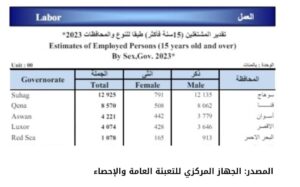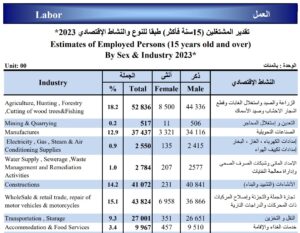Before the Disaster: Urgent Measures Needed to Protect Workers from Heat Stress Risks

With each heatwave, the issue of heat stress and related health effects from working in high temperatures and under direct sunlight comes to the forefront. Several workers in vital sectors across the country lack occupational safety standards to protect them from these dangers and lack sufficient protection against these effects.
Meanwhile, responsible authorities continue to ignore the necessary decisions to address unprecedented changes and increases in temperatures, exposing tens of millions of workers to the risks of numerous diseases, including cancer and heart diseases, potentially leading to death.
Caught Between Heat Stress and the Struggle for Livelihood
Heat stress is defined as the rise in ambient temperature beyond what a person can tolerate, posing numerous risks to their life. Symptoms include skin rash, dehydration, muscle cramps, heat exhaustion, dizziness, drowsiness, loss of appetite, and loss of consciousness, among others.
Moreover, the effects are increasing for workers in strenuous jobs that require direct exposure to heat, such as agriculture, fishing, mining, quarrying, timber, manufacturing, electricity and gas supplies, water supply, sewage networks, waste treatment, construction, wholesale and retail trade, vehicle repair, transport and storage, food and accommodation services, ovens, and delivery. Their number totals 21,798,800 workers according to the latest official statistics.
According to an academic study, the “extreme” temperature that a healthy person can endure for several hours is estimated at about 30 to 31 degrees Celsius in warm, humid environments.
Continuous Warnings and Governmental Neglect
Taking urgent measures to deal with the dangers of rising temperatures is no longer a luxury, especially given the increasing number of victims. Recent news reports indicated the death of about 50 Sudanese individuals and the injury of others due to heat strokes while attempting to enter Egypt illegally through the desert adjacent to Aswan. Hospitals received several bodies with peeled skin suffering from dehydration, while survivors stated that entire families died due to the high temperatures.
The Meteorological Authority warned on Sunday, June 9, 2024, of the longest heatwave of the month, lasting 10 days starting Wednesday, June 12, with temperatures exceeding 42 degrees Celsius in Cairo and over 47 degrees Celsius in Upper Egypt governorates.
Ministerial Decree No. 211 of 2003, regarding safety limits and the necessary precautions to mitigate physical, mechanical, biological, chemical, and passive risks and secure the work environment, issued by the Ministry of Manpower and Migration (now the Ministry of Labor), set permissible heat exposure limits in workplaces. It mandated rest periods from 25% to 75% of the working time based on workload and estimated temperatures from 25 to 32 degrees Celsius. The decree classified workloads into three categories: light (working on machines standing or sitting or performing light manual tasks), moderate (walking with light tasks or pushing/pulling), and strenuous (digging, loading, or carrying loads).
In 21 years, no amendments have been made to the ministerial decree despite temperature increases of about 17 degrees Celsius above the maximum stipulated. There have been no updates to review occupational safety and health policies in workplaces, even though the International Labor Organization has called for greater efforts to design, fund, and implement national policies to address heat stress risks and protect workers, including suitable infrastructure, improved early warning systems for heatwaves, and better implementation of international labor standards like occupational safety and health standards to help design policies addressing heat-related risks.
How the World Deals with Heat Risks in Workplaces
Many countries impose various measures to protect against health issues related to working in high temperatures and under direct sunlight. The latest International Labor Organization report on ensuring occupational safety and health in a changing climate, published in 2024, highlighted measures taken by these countries. For example, China halts outdoor work when temperatures exceed 40 degrees Celsius, while in Qatar, work stops when temperatures exceed 32.1 degrees Celsius. In Thailand, regulations require stopping low-intensity work at 34 degrees Celsius, moderate-intensity work at 32 degrees Celsius, and high-intensity work at 30 degrees Celsius.
Similar to Egypt, other countries are taking gradual measures to address heat stress effects in workplaces, according to heat measurement indices. These indices measure the ambient temperature around the worker, posing numerous risks, with death being the final stage.
For example, the Saudi Public Health Authority’s guideline for working in high temperatures and direct sunlight categorizes heat index values into four risk levels, aiding in appropriate actions based on temperature data. The classification sets less than 32.7 degrees Celsius as low caution, 32.7 to 39.4 degrees as moderate risk, 39.4 to 46.1 degrees as high, and above that as extremely high risk—a level recently reached in Egypt—mandating strict preventive measures and procedures.
Urgent Recommendations:
Given the severe risks of heat stress, sometimes resulting in death, the Egyptian Center for Economic and Social Rights emphasizes the need for the state to take emergency measures to address these risks, treating them as pandemics, natural disasters, and humanitarian crises with consequential effects. This includes obliging establishments and employers to implement preventive measures, intensifying inspections and oversight of non-compliant establishments, and firmly addressing violations to protect workers’ lives. Additionally, considering compensatory measures for workers’ losses due to these measures.
In addition, the Center calls for the development of centralized plans to enhance occupational safety and health and secure the work environment in light of current challenges, ensuring their implementation in coordination with relevant authorities. It reminds that workers injured under such conditions should be recognized as having sustained work-related injuries deserving compensation from the employer, alongside potential criminal accountability under labor and environmental laws.
In this context, the Center demands the reduction of working hours during these periods, with increased rest breaks in cool and shaded areas. It recommends scheduling heat-intensive work during cooler times of the day, limiting the physical demands on workers, assigning more workers to physically demanding tasks, and providing necessary equipment to reduce physical exertion. Additionally, cold water and fluids should be made available to workers with dedicated breaks for consumption. The appointment of trained monitors to detect and address health issues related to high temperatures and the availability of first aid supplies for immediate response are also urged.
Finally, the Egyptian Center urges the rapid implementation of the government’s digital transformation and service automation plan, such as health insurance, state-funded treatment, licensing, and real estate registration, particularly for patients and the elderly, as the most vulnerable and at risk of heat stress, to avoid additional health risks from exhaustion and psychological pressure due to traditional administrative procedures.




